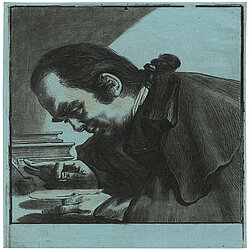Loading the page ...
Dominique Vivant-Denon
(1747 Givry – 1825 Paris)
Dominique Vivant, Baron Denon, was involved in a wide variety of activities and commissions in the course of his life as a diplomat, writer, museum director and collector, but his abiding passion was art. From his days as a student he regularly worked as a draughtsman, medal maker, etcher and lithographer, acquiring the requisite artistic skills mainly through his own endeavours. On the recommendation of Mme. Beauharnais, Napoleon took Denon with him on his expedition to Egypt (1798/99), which the artist recorded in a publication, and in 1802 appointed him director-general of the museums in France. He thus became the first director of the Louvre and, as assessor from 1805 of the European cultural assets confiscated by France, he became “Napoleon’s Eye”.
Denon left an extensive printed oeuvre of his own. He made his first lithograph in 1809 in the Munich studio of the brothers Aloys and Carl Friedrich Senefelder. Particularly after his resignation from office at the end of Napoleon’s rule Denon immersed himself in the art of lithography.
Denon’s extensive corpus of etchings encompasses reproductive engravings and prints after his own invention. The etchings in the latter category reflect his keen interest in art history. Quite often they are pasticci, as the artist himself called these imaginative variations on motifs by such renowned predecessors as Dürer, Bassano, Rembrandt and others. Denon’s originality and characteristic verve are shown off to best effect, however, in his little genre scenes.
Archive
